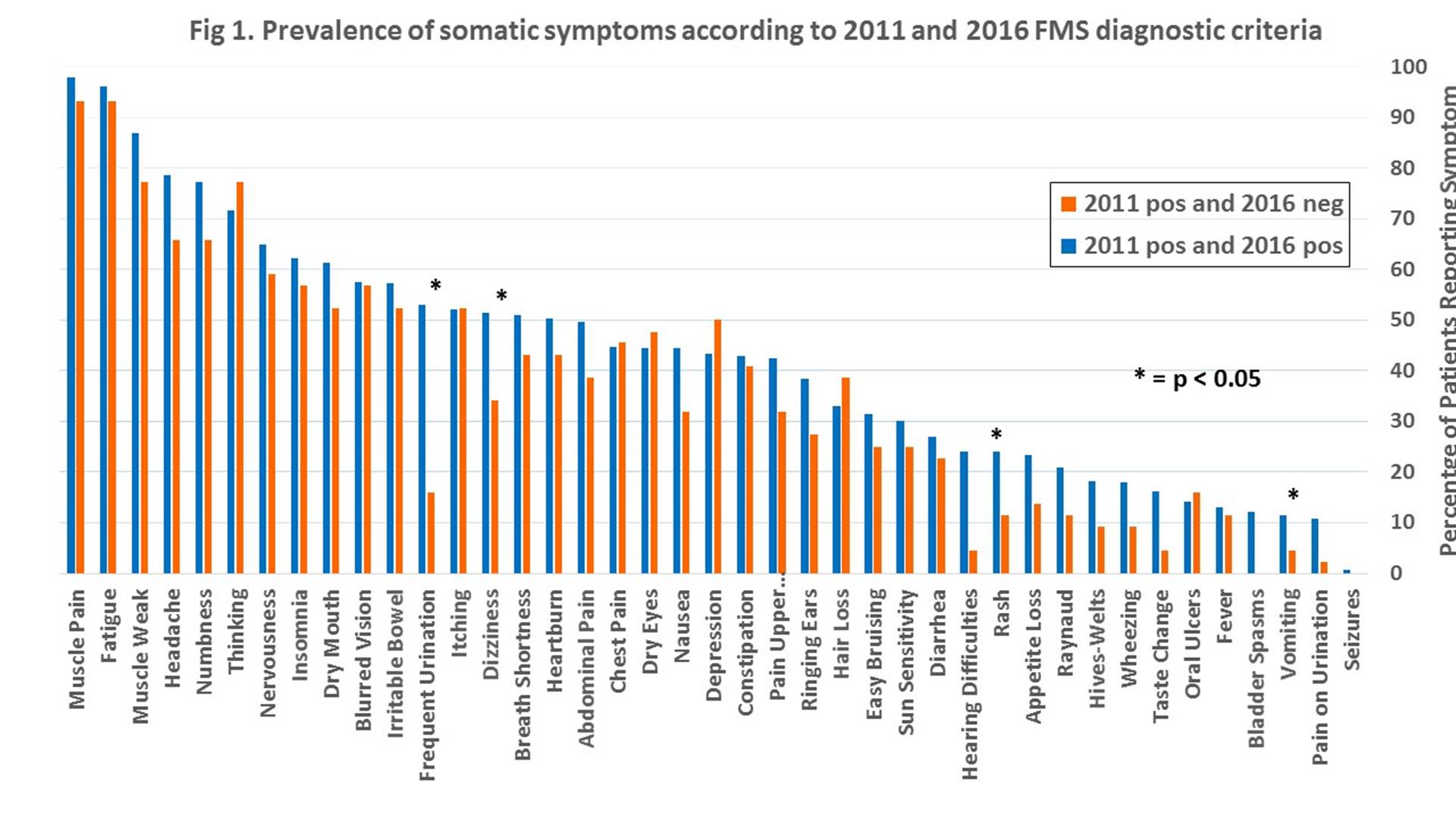Session Information
Date: Sunday, November 5, 2017
Title: Fibromyalgia, Soft Tissue Disorders, Regional and Specific Clinical Pain Syndromes Poster I
Session Type: ACR Poster Session A
Session Time: 9:00AM-11:00AM
Background/Purpose: The 2010/2011 fibromyalgia (FMS) diagnostic criteria (1) were recently revised, with the addition of a generalized pain criterion in order to avoid misclassification of regional pain syndromes; furthermore, the diagnosis of fibromyalgia is now valid irrespective of other diagnoses. Aim of the present study was to evaluate whether patients classified as having (2016+) or not having (2016-) FMS by 2016 revised criteria truly represent different populations.
Methods: 334 patients (306 F and 28 M) with a diagnosis of FMS according to 2011 criteria were included in the study; mean age was 46.82 yrs (range 16 – 75), and mean disease duration 6.25 yrs (range 3 months -34 yrs). Widespread Pain Index (WPI) and Symptom Severity Scale (SSS) were assessed by a localized version of the Fibromyalgia Survey Questionnaire; furthermore, patients were asked to report the presence or absence -in the last 7 days- of each of the 41 somatic symptoms suggested by the original 2010 classification paper (2). An evaluation of overall pain level in the last 7 days (0-10 numeric rating scale, NRS), and of fatigue by the FACIT-Fatigue questionnaire were available in 101 and 137 patients respectively. Statistical analysis was performed by IBM SPSS v 22. Differences of mean values and of proportions were evaluated by parametric or non-parametric methods as appropriate.
Results: the diagnosis of FMS was confirmed by 2016 criteria in 290 (86.8%) patients, and not confirmed in 44 (13.2%) patients. Mean age (47.62 ± 10.6 yrs vs 46.69 ± 11.7 yrs, p=0.625), mean disease duration (6.27 ± 6.37 vs 6.25 ± 6.10 yrs, p=0.982), the percentage of females (93.2% vs 91.4%, p=0.688), and the association with other clinically relevant diseases (27.3% vs 18.6%, p=0.179) were not different in the 2016- group as compared to 2016+ group. 2016- patients had significantly lower values of polysymptomatic distress scale (PSD: 16.59 ± 2.4 vs 21.86 ± 4.5 p < 0.001), and of pain-related variables (WPI: 7.57 ± 2.1 vs 12.66 ± 3.4, p< 0.001; TP: 10.54±5.4 vs 13.28 ± 4.3, p=0.001; NRS: 5.64 ± 2.9 vs 7.46 ± 1.9 p=0.022). SSS was similar in the 2 groups (9.03 ± 1.9 vs 9.20 ± 1.9 p=0.599), but the number of somatic symptoms reported was significantly lower in 2016- patients (14.44 ± 5.0 vs 17.49 ± 6.6 p=0.005, Fig. 1), which reported higher levels of fatigue (FACIT-Fatigue 28.3 ± 10.8 vs 21.17 ± 10.0, p=0.010).
Conclusion: The rate of disagreement between 2011 and 2016 criteria (13.2%) in our study is very close to the results (13.8%) reported in the only comparison study published to date (3). Patients failing to meet 2016 criteria seem to represent a truly different population, characterized by lower polysymptomatic distress, lower overall pain, and fewer somatic symptoms.
References:
1. Wolfe F, et al. Semin Arthritis Rheum. 2016 Dec;46(3):319-329
2. Wolfe F, et al. Arthritis Care Res (Hoboken). 2010 May;62(5):600-10
3. Ablin JN, Wolfe F. J Rheumatol. 2017 Jun 1. [Epub ahead of print]
To cite this abstract in AMA style:
Antivalle M, Ditto MC, Batticciotto A, Talotta R, Gerardi MC, Mutti A, Atzeni F, Sarzi-Puttini P. Patients Failing to Fulfill 2016 Criteria for Fibromyalgia Represent a Truly Different Population Subset [abstract]. Arthritis Rheumatol. 2017; 69 (suppl 10). https://acrabstracts.org/abstract/patients-failing-to-fulfill-2016-criteria-for-fibromyalgia-represent-a-truly-different-population-subset/. Accessed .« Back to 2017 ACR/ARHP Annual Meeting
ACR Meeting Abstracts - https://acrabstracts.org/abstract/patients-failing-to-fulfill-2016-criteria-for-fibromyalgia-represent-a-truly-different-population-subset/

